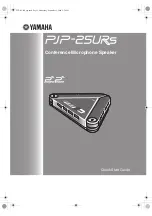
engineered sound
®
microphones
ES963
Three-Element Multidirectional Boundary Microphone
Features
• Three cardioid condenser elements mounted in a single housing
• Easily reposition two elements (via levers on the microphone
base) to adjust the acceptance angle of the microphone from 360°
to 300°; each element can be powered and used individually or in
any combination
• Also functions as a stereo boundary microphone
• Provides full, efficient and flexible coverage of conference tables—
fewer microphones required
• Small-diameter capsules near boundary eliminate phase distortion
and deliver clear, high-output performance
• Low-frequency attenuation improves sound pickup without
affecting voice quality
• Cable routes through any of four recessed pathways on the
microphone base (or down for direct feed through a table surface);
no tools or disassembly required
• UniGuard
®
RFI-shielding technology offers outstanding rejection
of radio frequency interference (RFI)
• Heavy die-cast case and non-slip silicon foam bottom pads minimize
coupling of surface vibration to the microphone
• Low-profile design with low-reflectance finish for minimum visibility
Description
The ES963 is a three-element multidirectional condenser microphone.
It is designed for surface-mount applications such as high-quality sound
reinforcement, conferencing, professional recording, television and other
demanding sound pickup applications.
The microphone requires 11V to 52V DC phantom power for operation.
Elements can be powered and used individually, or in any combination.
The microphone is equipped with UniGuard
®
RFI-shielding technology,
which offers outstanding rejection of radio frequency interference (RFI).
Three cardioid condenser elements mounted in the microphone housing
are factory set with an angle of 120º between them to provide complete
360º coverage (in the hemisphere above mounting surface). Two positioning
levers on the microphone base allow two of the three elements to be
reoriented (with no tools or disassembly required) to offer angles of
90º/90º/180º between elements – ideal for positioning at the end of long
conference tables, for example.
Four recessed pathways on the base of the microphone enable the
user to route the cable as necessary to accommodate any installation
requirements; no tools or disassembly are needed. The cable can also be fed
directly down from the microphone base to route through a table surface.
The microphone includes a 7.5 m (24.6’) permanently attached output cable.
Its free end is unterminated stripped and tinned pigtails. This allows the
installer flexibility in interfacing with a variety of equipment. For custom
installation, refer to the wiring chart for termination connection.
The microphone’s heavy die-cast case and non-slip silicon foam bottom
pads minimize coupling of surface vibration to the microphone. The
microphone includes a soft protective pouch and features a low-reflectance
black finish.
Installation and Operation
The ES963 requires 11V to 52V DC phantom power for operation.
Output from the microphone is low impedance (Lo-Z) balanced. The signal
appears across the pair of colored wires (red and yellow wires for Element 1,
white and blue wires for Element 2, green and brown wires for Element 3);
audio ground is the shield connection. Output is phased so that positive
acoustic pressure produces positive voltage on the yellow, blue and
brown wires.
The microphone should be placed on a flat, unobstructed mounting surface.
The sound source should not be below, or higher than 60° above, the plane
of the mounting surface. The fixed element (3) is facing the front of the
microphone, indicated by the Audio-Technica logo on the exterior housing.
For 360° coverage, slide each of the two microphone positioning levers
on the microphone base to the 120° positions. At this setting, ideal for
providing omnidirectional coverage of four people at a round table, there
will be 120° between elements; each of the two moveable elements (1 and 2)
will face a triangle printed on the microphone’s exterior housing (
see Fig. A
).
For 300° coverage, slide each of the two microphone positioning levers on
the bottom of the microphone to the 90° positions. At this setting, ideal
for covering three people at the end of a table, there will be 90° between
elements; each of the two moveable elements (1 and 2) will face a circle
printed on the microphone’s exterior housing (
see Fig. B
).
Figure A Figure B
Since elements can be powered and used individually or in any combination,
further flexibility is easily achieved. For example, with two elements
powered (1 and 2 in the 120° positions) and the (unpowered) stationary
element pointed away from the sound source, the microphone provides the
functionality of a stereo boundary mic; with two elements powered (1 and
2 in the 90° positions), the microphone provides figure-of-eight coverage;
with a single element powered, the microphone functions as a standard
cardioid boundary microphone.
The cable may be routed through one of the four recessed pathways on
the microphone base (or down for direct feed through a table surface)
to accommodate any installation requirements without the need for tools
or disassembly.
Avoid leaving the microphone in the open sun or in areas where
temperatures exceed 43°C for extended periods. Extremely high humidity
should also be avoided.
Note:
Placing any object on a surface (such as a conference table) before
its finish is fully cured may result in damage to the finish.
Architect’s and Engineer’s Specifications
The microphone shall be a three-element multidirectional fixed-charge
condenser designed for use in surface-mount applications. It shall have
three cardioid elements (cardioid in hemisphere above mounting surface)




















